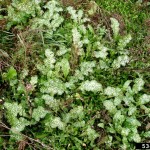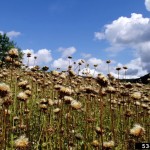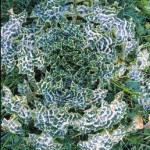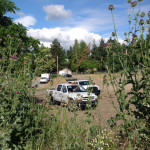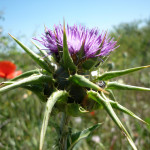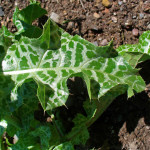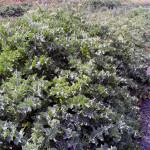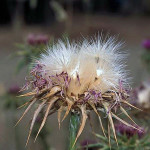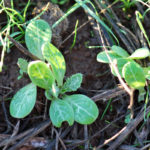Common name:
Blessed milkthistle, Milk thistle, Marian thistle, Mary thistle, Saint Mary’s thistle, Mediterranean milk thistle, Variegated thistle
Scientific Name:
Silybum marianum. (Syn. Carduus marianus)
Noxious Weed Listing:
Description:
General:
Blessed milkthistle is a sparsely branched thistle growing up to 6 feet tall and forming dense stands. It’s a tap-rooted biennial or annual that forms large rosettes followed by 2 inch purple blooms borne singly on unbranched, grooved and somewhat cottony stems.
Leaves:
Leaves are oblong to lanceolate, hairless, shiny dark green with distinctive white patterns running along the veins, reaching up to 20 inches long and 10 inches wide. The white mottling gives the plant the appearance of having been drenched in milk, thus the common name. Leaf margins are tipped with spines up to 1/2 inch in length. Large rosettes can reach 3 feet in diameter.
Flowers
Solitary composite red-purple flowers reach 2 inches in diameter and are surrounded by leathery, spiny, hairless bracts. The all-disk flowers are similar to other thistles, with large spines extending out in layers from under the pincushion-flower head. Plants flower from April to October.
Fruits
Dark brown, relatively heavy hairless achenes, about 1/2 by 1/4 inch, form in autumn.
Roots
Plants grow from long white taproots.
Reproduction:
Reproduction is from seeds. Plants are typically biennial in our area, so they die after going to seed. Seeds are relatively heavy and dispersal is usually by animals, equipment, vehicles or contaminated hay. Plants can produce more than 6,000 seeds per year which can remain viable in the soil for at least 9 years, where disturbance will cause them to germinate. Seeds often germinate following the first rains of the season but may continue to germinate through the winter.
Habitat:
Blessed milkthistle can be found in full sun or part shade. They typically grow in heavily grazed pastures and on roadsides where nitrogen is high and disturbance regimes are frequent. This plant is also traded horticulturally and found in ornamental and medicinal gardens.
Impacts:
- A serious threat to livestock. Ingestion by livestock can cause nitrate poisoning and death.
- Forms dense stands that shade out forage species and exclude livestock.
- Spines can cause injury to people and livestock.
- Displaces native vegetation.
Introduction:
Native to southern Europe, blessed milkthistle was probably introduced to the US as a medicinal plant by early colonists. It has become common in Canada and throughout the southern United States.
Distribution:
Clackamas County :
Blessed milkthistle is relatively rare in Clackamas County, with populations associated with disturbed and unmanaged sites. Milkthistle is occasionally cultivated as an herbal supplement.
State of Oregon:
United States:
Management:
Strategy:
The management of invasive weeds is best served through a process know as Integrated Pest Management (IPM). IPM is a weed management methodology that utilizes:
- Management thresholds to determine when and if to initiate control,
- The ecology and life history characteristics of the targeted invasive weed,
- Site-specific conditions and land use considerations to inform management practices,
- The effectiveness and efficiency of various control methods.
An IPM based strategy ensures the maximum effectiveness of treatment measures. IPM strategies typically use more than one management method to target one or more susceptible life stages. It is adaptive to site conditions in the field and to the response of a plant to management. The utilization of multiple management tools also inherently reduces the use of herbicides in a management plan. The IPM process ultimately provides a framework for the establishment of Best Management Practices (BMP’s), which outlines the best approach for controlling a weed particular infestation.
Manual:
Blessed milkthistle responds well to manual control for small outbreaks. Dig plants whenever you find them, prior to flowering. Once they are flowering, be sure to carefully bag and dispose of plants to prevent seed set. Viable seeds will continue to form after plants are dug up and it can be difficult to contain mature seed heads without spreading seeds. In this case, carefully remove and bag all flower and seed heads before digging plants. Where mature plants are removed search carefully for small rosettes or germinating seeds. Return to the same location in spring and fall, and continue to monitor for several years. For best control, sow native plant seeds on disturbed soils to suppress milkthistle germination.
Mechanical:
Cultivation and tillage can be effective control options for seedlings, but soil disturbance will increase germination in the soil seed bank. Mowing will not eradicate milkthistle. Plants are able to re-sprout and flower in the same season after being mowed. Plants can persist as perennials in a regular mowing cycle and may flower below the level of the mower, spreading seeds to new areas. Mowing may also increase the amount of toxic material ingested by grazing animals, as milk thistle becomes more palatable as it wilts. If you do mow near a milkthistle infestation, be sure to clean your mower to prevent spreading seeds to new locations.
Cultural:
Good grazing practices and management for grasses and forage species will reduce the disturbance regime and decrease the opportunity for milk thistle to become established. Minimize soil disturbance and re-vegetate to prevent infestations. Burning is not an effective control and can encourage seed germination and establishment.
Chemical:
Herbicides should only be used at the rates and site conditions specified on their label.
For control of large milk thistle infestations, apply a selective broadleaf herbicide and surfactant in the spring and again in the fall. Infested areas should not be mowed until the herbicide has had a chance to work. Continue to monitor areas in spring and autumn for several years following treatment.
Before you Start:
- Before purchasing any herbicide product it is important to read the label. The label is the Law. Carefully review all parts of the label even if you have used the product before. Select a product that is most appropriate for your site. If you have questions, ask your vendor before purchasing a product.
- When selecting herbicides always use a product appropriately labeled for your site. Follow label recommendations and restrictions at all times. If any information provided here contradicts the label, the label takes precedence. Always follow the label!
- Protect yourself. Always wear the recommended protective clothing identified on your label and shower after use.
- When applying herbicides use spot spray techniques whenever possible to avoid harming non-target plants.
- Do not apply during windy or breezy conditions that may result in drift to non-target plants
- Avoid spraying near water. Hand-pull in these areas, to protect aquatic and riparian plants and wildlife.
- Avoid exposure to pets, pollinators, and wildlife. Remove animals from treatment areas to avoid exposure to herbicides. Follow the reentry instructions on your herbicide label and keep pets out of the area until the herbicides have dried. Avoid spraying when insects and animals are active. Avoid spraying blooming plants to minimize any effects to bees and pollinators.
- Be sure to store any chemicals, out of the reach of children and pets to keep your family safe.
- Product labels and formulations change regularly. Check the Pacific Northwest Weed Management Handbook and the label for current control recommendations.
Herbicides:
The mention of any brand name product is not, and should not be construed as an endorsement for that product. They are included here only for educational purposes. Suggested rates are generalized by active ingredient. Specific rates will vary between products. Be sure to review the label before application and use the recommended label rate at all times.
Active Ingredients
Product Names: Many products
Rate: 3-4 pt product/acre (1.43 to 1.9 lb a.e./acre)
Time: Apply post emergence in spring or fall to young, growing plants.
Comments: 2,4-D is a broadleaf-selective herbicide without residual soil activity. Treat rosettes in the fall. Use spring treatments prior to flower stalk elongation. Treat annually for several years to control seedlings.
Product Names: Milestone
Rate: 3-5 oz product/acre (0.75 to 1.25 oz a.e./acre)
Time: Apply post emergence in spring or to early summer to rosettes and bolting plants. Apply in fall to seedlings and rosettes.
Comments: Aminopyralid is a broadleaf-selective herbicide with moderate soil residual activity. A non-ionic surfactant can enhance control under adverse environmental conditions.
Product Names: Transline
Rate: 0.25-1 pt product/acre. (1.5-6 oz a.e/acre) Spot treatment: 1-2% v/v solution
Time: Apply post emergence from the seedling to bud stage, when plants are rapidly growing
Comments: Generally safe for grass but will harm members of Asteraceae and Fabaceae
Product Names: Curtail
Rate: 1-5 qt product/acre.
Time: Apply post emergence to basal rosettes from spring until bud stage.
Comments: This is a non-selective product and neither compound has soil activity. Replant sprayed area to prevent re-establishment of milk thistle.
Product Names: Banvel, Clarity
Rate: 1-2 pt product/acre (0.5-1 lb a.e./acre).
Time: Apply post emergence to basal rosettes from spring until bud stage.
Comments: This is a non-selective product and neither compound has soil activity. Replant sprayed area to prevent re-establishment of milk thistle.
Product Names: Campaign
Rate: Broadcast foliar treatment: 1-2 pt product/acre. Spot treatment: 1-2% v/v solution
Time: Apply post emergence in spring to rosettes, or in fall before a freeze.
Comments: This is a non-selective product and neither compound has soil activity. Replant sprayed area to prevent re-establishment of milk thistle.
Product Names: Telar
Rate:1 oz product/acre (0.75 oz ai/acre)
Time: Apply post emergence, to rapidly growing plants
Comments: Chlorsulfuron is primarily active against broad-leaf plants and generally will not harm grasses. It has long soil activity. Do not apply to dry, powdery, or sandy soils unless rain is expected.
Product Names: Escort
Rate:1 oz product/acre (0.6 oz ai/acre)
Time: Apply post emergence, to rapidly growing plants
Comments: Metsulfuron is primarily active against broadleaf plants and generally will not harm grasses. It has some soil activity. Use a non-ionic or silicone-based surfactant to increase effectiveness.
Biological:
Blessed milkthistle is impacted by Rhinocyllus conicus, a seed head weevil first released in 1979. Rhinocyllus conicus is widespread in Oregon and feed heavily on blessed milkthistle. The presence of Rhinocyllus conicus offered excellent control of blessed milkthistle but is not recommended. Rhinocyllus conicus targets many native thistles species, and its redistribution is discouraged. Interstate distribution of this biological control is prohibited.
Disposal:
Bag all flowers and seed heads and dispose of in the garbage. Seeds will continue to mature after a plant is pulled. Do not compost seeds or flower heads.
Follow-Up:
Sites should be monitored for several years after the removal of mature plants. Viable seeds can last at least 9 years in the soil.
Best Management Practices:
Small Infestations:
- Consider the land use practices on site. Identify site-specific considerations that should be taken into account before initiating control.
- Be sure you can properly identify blessed milkthistle. If you are unsure about your weed, bring a sample to the Conservation District and we can help to identify your particular plant.
- Identify any native or desirable plants nearby, and take precautions to minimize any negative impact on them.
- Small infestations can be controlled manually by digging entire plants. Dispose of plants by bagging the entire plant and placing in the garbage. Do not compost or feed to livestock.
- Replace any divots created when removing the plants to lessen the amount of disturbed soil.
- If using herbicide, apply using a spot spray technique to minimize non-target injury.
- Monitor site throughout growing season and remove any new plants.
- If using an herbicide in a grassy area, use a selective herbicide with a non‐ionic surfactant to avoid injury to the grass.
- If using herbicides where livestock may be present, be aware of grazing restrictions and damage to forage plants.
Large Infestations:
- Consider the land use practices on site. Identify site-specific considerations that should be taken into account before initiating control.
- Be sure you can properly identify blessed milk thistle. If you are unsure about your weed, bring a sample to the Conservation District and we can help to identify your particular plant.
- Identify any native or desirable plants nearby, and take precautions to minimize any negative impact on them.
- Apply selective herbicides with a non‐ionic surfactant in the spring before any flowers appear.
- Remove all grazing animals from infested areas.
- Apply herbicide utilizing a spot spray or broadcast application.
- Apply herbicide on warm days when winds are low.
- Try not to disturb the soil. Replace any divots created. Maintain a healthy vegetative cover.
- Continue to monitor site throughout growing season and for a few years post-treatment. Remove any new growth.
- Check the label for specific information on wind and rain guidelines.
Fun Facts:
- Silymarin is a chemical extracted from the blessed milkthistle seeds, is thought to help repair liver cells damaged by alcohol and other toxic substances, including the toxins found in Amanita phalloides, the death cap mushroom.
- Blessed milkthistle has been used medicinally for over 2000 years.
- Blessed milkthistle is a nitrogen accumulator, and can cause nitrate poisoning in livestock.
Gallery:
- Blessed milkthistle infestation
- Blessed milkthistle seedlings
- Blessed milkthistle seedheads
- Blessed milkthistle (Silybum marianum) rosette
- Mature blessed milkthistle
- Blessed milkthistle
- Blessed milkthistle (Silybum marianum) flower head
- Blessed milkthistle leaf
- Blessed milkthistle seedling
- Blessed milkthistle rosettes
- Blessed milkthistle fruits
- Milkthistle seedlings emerging after the onset of fall rains.
Additional Information:
- Washington State Noxious Weed Control Board: Silybum marianum
- Oregon State University Extension: Invasive Weed ID and Management
- Weed Control in Natural Areas in the Western United States
- Pacific Northwest Weed Management Handbook: Thistle Control
- King County Washington: Blessed milkthistle Best Management Practices
- Center for Invasive Species and Ecosystem Health
References:
- DiTomaso, J.M., G.B. Kyser, S.R. Oneto, R. G. Wilson, S. B. Orloff, L. W. Anderson, S. D. Wright, J.A. Roncoroni, T.L. Miller, T.S. Prather. 2013. Weed Control in Natural Areas in the Western United States. Davis, CA: UC Weed Research and Information Center. pp 371-2.
- King County Noxious Weed Control Program. 2011. King County Noxious Weed Control Program, Best Management Practices: Milk Thistle. https://your.kingcounty.gov/dnrp/library/water-and-land/weeds/BMPs/Milk-Thistle-Control.pdf (Retrieved Jan. 6, 2015).
- Oregon Flora Project. 2013. Oregon Plant Atlas: Rubus bifrons. https://www.oregonflora.org/atlas.php. (Retrieved Jan. 6, 2015)



